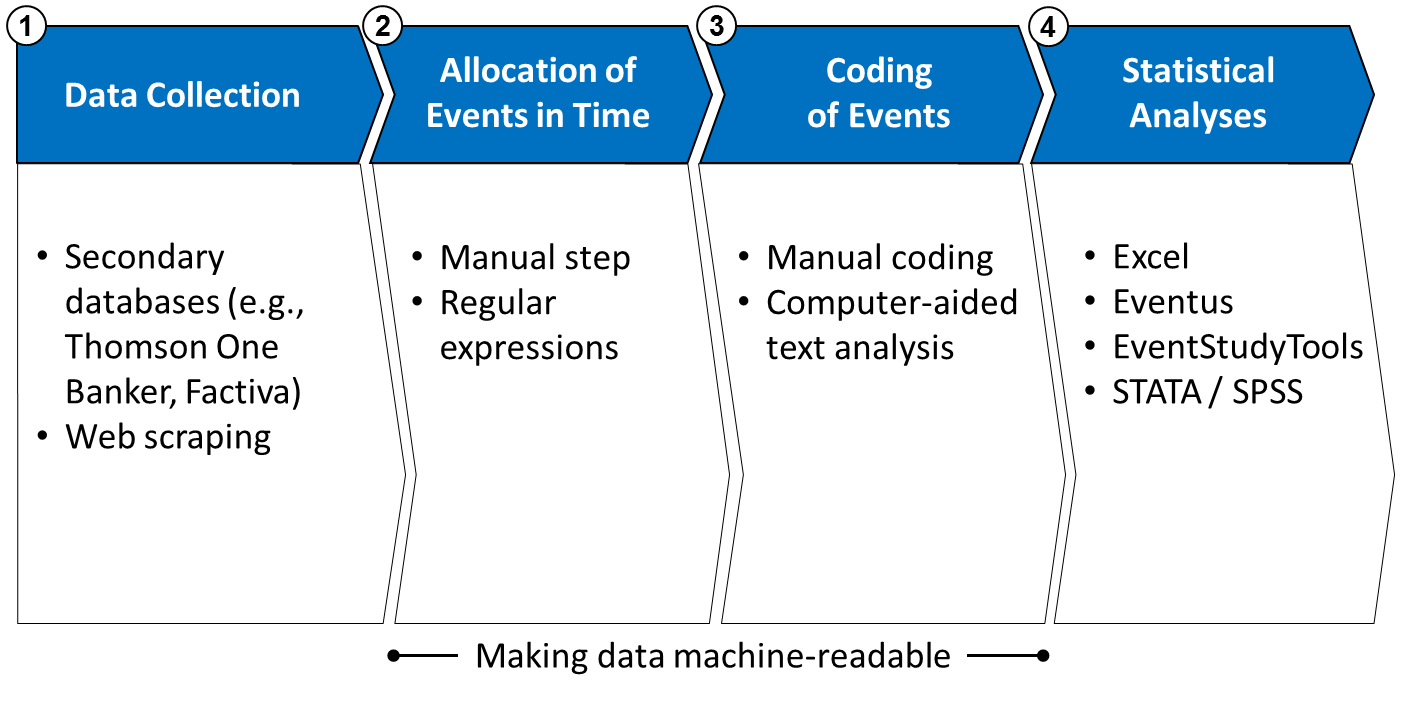Case Study Writing With News Analytics
EventStudyTools' research apps help you overcome two critical empirical challenges in writing case studies:
- Our news analytics research apps help you to accurately map the competitive actions of firms over extended periods of time and thus create the chronicle of strategic change you may want to study (Chakravarthy & White, 2001).
- Our event study research apps help you to quantify stock market responses to firms' competitive actions or market shocks, which allows you to add the capital market perspective to your case study.
The news analytics research apps were designed with the analysis of press releases in mind. Consider press releases as a source of empirical data for your case study research. They have several advantages:
- You receive a longitudinal dataset that typically stretches across many years
- Given strong reporting regulations in many countries, press releases provide you with the granular coverage of the studied companies change efforts and other impactful events
To sum up, for case study writing, EventStudyTools' research apps give you access to computational methods (e.g. text analysis) and techniques (e.g., regular expressions) that can be combined with newly arising technological opportunities (e.g., web data scraping of press releases) in an innovative form of longitudinal organizational change research (Van de Ven, Polley, Garud, & Venkataraman, 1999; Van de Ven & Poole, 1995).
This empirical strategy allows for large samples of individual firm cases covering resource allocation decisions, competitive actions, and governmental changes (Eisenhardt, 1995; see the website's section on competitive dynamics research for more details on firms' action sequences). Additionally, the website's abnormal return calculators allow you to include stock market responses to firms' competitive actions in your research. Figure 1 and the subsequent paragraphs illustrate the empirical challenges of writing case studies that ground on news analytics.
Figure 1: Empirical Challenges of Writing Case Studies that Use News Analytics

(1) Data Collection: Case studies typically tell a story about the organizational behavior of firms. There are different ways to document firm behavior: You may manually capture the firm's competitive actions through traditional manners, such as expert interviews. Alternatively, you can scrape the organization's press releases and identify the respective competitive actions using computer-aided text analysis. This latter automated approach rapidly gains popularity as it allows for larger samples. If you want to retrieve news from other sources than the firms' websites, you may make use of news aggregators that consolidate sources. The following video gives you an impression of the advanced filtering options that you can expect from such aggregators.
(2) Allocation of Events in Time: Writing case studies that use news analytics requires you to allocate individual news items in time. While this can easily be done by hand for a small sample, larger news samples suggest the use of an automated approach. This website's regular expression-based (event) date identifier (EDI) is capable of process large volumes of press releases and hands you back all dates mentioned within the release texts.
(3) Coding of Events: For an automated solution, you should use the website's keyword-based computer-aided text analyzer.
(4) Statistical Analysis: Your choice of analysis tool should be informed by your research question. If you seek to complement your case study by assuming the capital market perspective on the firm strategic decisions you analyze, you may draw on this website's abormal return calculators. For an introduction to the methodology, which may inform your decision to use or not use the methodology, you may view the following third-party video from youtube.
References
Chakravarthy, B., & White, R. 2001. Strategy process: Forming, implementing and changing strategies. Handbook of strategy and management: 182-205. London: Sage Publications.
Eisenhardt, K. 1995. Building theories from case study research. In G. Huber and A. Van de Ven (Eds.), Longitudinal field research methods. Studying processes of organizational change: 65-90. Thousand Oaks: Sage Publications.
Van de Ven, A., Polley, D., Garud, R., & Venkataraman, S. 1999. The innovation journey. New York: Oxford University Press.
Van de Ven, A., & Poole, M. 1995. Methods for studying innovation development in the Minnesota Innovation Research Program. In G. Huber and A. Van de Ven (Eds.), Longitudinal field research methods. Studying processes of organizational change: 155-185. Thousand Oaks: Sage.
